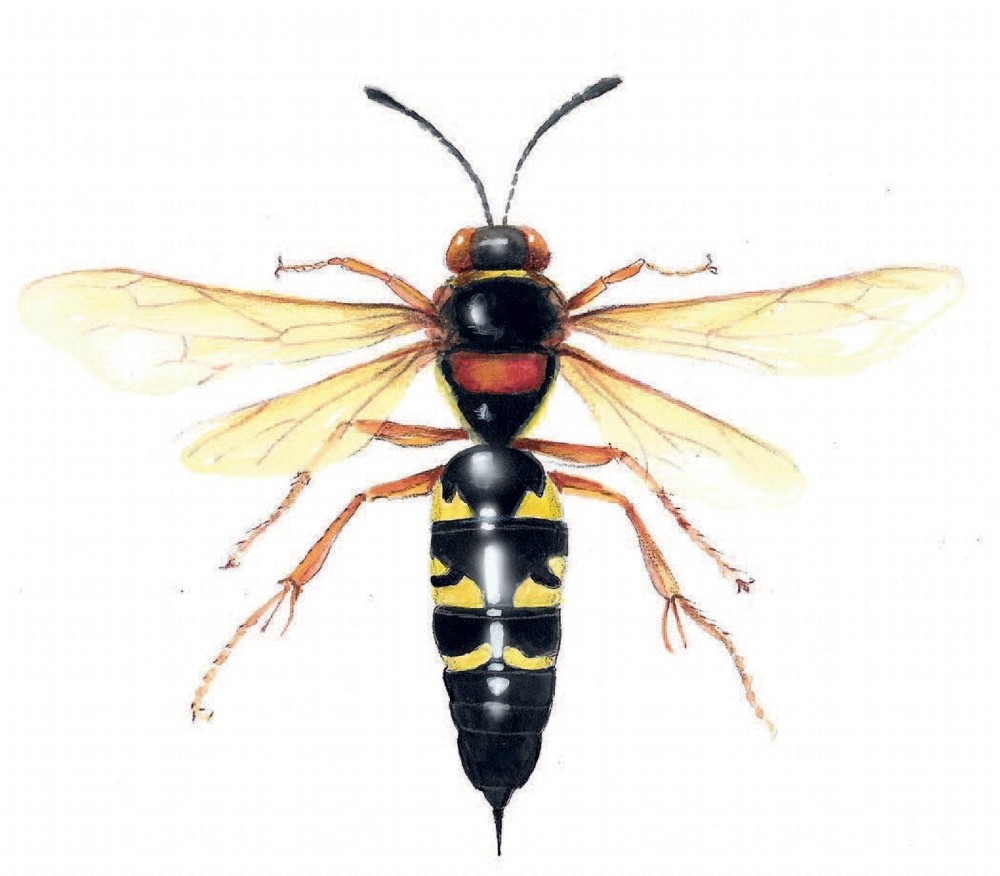
Picture this: you are a single mother, and to ensure the success of your children, you’ll have to immobilize a still-living animal almost twice your weight and haul it back to a tunnel you dug into the side of a hill. You then have to repeat this task once or twice for each of your approximately 20 children.
Female eastern cicada killers (Sphecius speciosus) perform remarkable feats on behalf of their offspring, repeatedly catching, carrying, and burying insects that are much bigger and heavier than they are. They’re formidable predators, and look the part. Measuring about 2 inches in length (about 25 percent bigger than males), they are the largest native wasps in North America.
However, despite an intimidating name and prominent black-and-yellow stripes that scream “DANGER,” both male and female cicada killers are quite docile. The males lack functioning stingers and aren’t killers at all, instead feeding on nectar and sap. As for the females, you would have to try hard to be stung by one, and even then, the sting isn’t especially painful. I’m not advocating this next behavior, but entomologist Justin Schmidt, creator of the Schmidt sting pain index, deliberately subjected himself to stings by two cicada killer species and determined that the pain was less than that inflicted by a honey bee.
Cicada killers hunt both annually emerging and periodical cicadas. (No doubt 2024, with coinciding emergences of both 13-year and 17-year cicada broods, is a boom year.) Regardless of which of the 30 or so cicada species are available, the females’ preparations are the same. These industrious wasps tunnel into sandy earth, kicking back dirt like miniature six-legged dogs. They regularly turn around and use their forelegs and face to bulldoze soil away from the tunnel entrance. Their tunnels extend as far as 4 feet underground (that’s comparable to a person digging a 120-foot tunnel). From this main tunnel, the wasps excavate side chambers, one for each of their offspring.
Substantial piles of sand near tunnel openings are often the first sign that these impressive wasps have taken up residence in your yard or garden. Because they require sandy soil to dig their nests, several females often crowd into the same habitat, with little space between tunnel openings. Digging is hard work, and cicada killers sometimes save energy by sharing tunnels. In one study, scientists netted and removed 50 female wasps from 40 tunnels without making a measurable dent in the frequency of wasp visits. This behavior can give the appearance of a colony, but cicada killers are considered solitary wasps because there is not a colony queen, and they do not help to care for each other’s offspring.
Those offspring are the reason these impressive black-and-yellow wasps catch so many cicadas. Growing large wasps from tiny eggs requires ample nutrition, and female wasps fly out repeatedly to find and collect new prey. If you have experienced cicadas in the summer, you might reasonably expect that any predator interested in cicada-on-the-hoof would rely on sound to find the insects. As with many wasp species, however, cicada killers appear to use sight to find their prey. They catch twice as many female cicadas, which are silent but spend more time on tree branches where cicada killers hunt. Entomologists have also speculated that ovipositing female cicadas are “sitting ducks” for wasps on the prowl.
Regardless of prey gender, a female cicada killer does not immediately kill the cicada. Instead, she grapples with the larger insect, overpowers it, and stings it a single time, injecting a cocktail of chemicals that paralyze it. The wasp then flips the immobilized cicada onto its back and grasps it belly to belly before flying it back to the freshly dug tunnel.
“Flight” in this case is a relative concept. Cicada killers lack the necessary equipment to take off and actively fly while carrying an insect that weighs 90 percent more than they do. To compensate, a cicada killer will climb and glide between a series of trees and shrubs with its prize in tow to hopscotch back to the tunnel entrance before landing and dragging the cicada underground.
The wasp stocks each larval chamber with one to three cicadas, positioning them side-by-side on their backs with their heads pointing away from the chamber entrance. She lays a single egg under the femur of a cicada’s middle leg, then plugs the chamber entrance. Once she has finished this process for every chamber, her herculean task is complete, as is her lifespan.
The eggs hatch within a day or two and the larvae eat the still-living cicadas one at a time until they exhaust the supply, a process that takes about a week. Then the larvae construct silken cocoons that they suspend centrally in their side tunnels, using tethers attached to the walls in all directions. They will spend winter there, pupate in late spring, and emerge as adults in midsummer, tunneling vertically to the surface.
Cicada killers inhabit all the lower 48 states including the Champlain Valley and southern Maine. So if a very large wasp shows up where you live, don’t assume that it’s a hornet (murder or otherwise); it could be a cicada killer. And if you are fortunate enough to snap a photo of one of these spectacular insects, consider sharing it on iNaturalist for posterity.


